Washer (hardware)

A washer is a thin plate (typically disk-shaped) with a hole (typically in the middle) that is normally used to distribute the load of a threaded fastener, such as a screw or nut. Other uses are as a spacer, spring (belleville washer, wave washer), wear pad, preload indicating device, locking device, and to reduce vibration (rubber washer). Washers usually have an outer diameter (OD) about twice larger than their inner diameter (ID).
Washers are usually metal or plastic. High-quality bolted joints require hardened steel washers to prevent the loss of pre-load due to Brinelling after the torque is applied.
Rubber or fiber gaskets used in taps (or faucets, or valves) to stop the flow of water are sometimes referred to colloquially as washers; but, while they may look similar, washers and gaskets are usually designed for different functions and made differently.
Washers are also important for preventing galvanic corrosion, particularly by insulating steel screws from aluminium surfaces.
The origin of the word is unknown; the first recorded use of the word was in 1346, however, the first time its definition was recorded was in 1611.[1]
Type and form
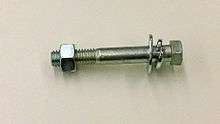
Washers can be categorised into three types;
- Plain washers, which spread a load, and prevent damage to the surface being fixed, or provide some sort of insulation such as electrical
- Spring washers, which have axial flexibility and are used to prevent fastening loosening due to vibrations
- Locking washers, which prevent fastening loosening by preventing unscrewing rotation of the fastening device; locking washers are usually also spring washers.
The American National Standards Institute (ANSI) provides standards for general use flat washers. Type A is a series of steel washers with broad tolerances, where precision is NOT critical. Type B is a series of flat washers with tighter tolerances where outside diameters are categorized as "narrow", "regular" or "wide" for specific bolt sizes.[2]
"Type" is not to be confused with "form" (but often is). The British Standard for Metric Series Metal Washers (BS4320) written in 1968 coined the term "form". The forms go from A to D for Bright Metal and denote outside diameter and thickness:
- Form A: Normal diameter, normal thickness
- Form B: Normal diameter, light thickness
- Form C: Large diameter, normal thickness
- Form D: Large diameter, light thickness
- Forms E to G relate to black metal washers.
Plain washers
| Name(s) | Image | Description |
|---|---|---|
| Plain washer (or "flat washer") | 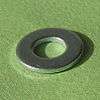 |
A flat annulus or ring, often of metal, used to spread the load of a screwed fastening. Additionally, a plain washer may be used when the hole is a larger diameter than the fixing nut.[3][4] |
| Fender washer (US), penny washer or "repair washer" (UK) | 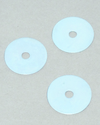 |
A flat washer with a particularly large outer diameter in proportion to its central hole. They are commonly used to spread the load on thin sheet metal, and are named after their use on automobile fenders. They can also be used to make a connection to a hole that has been enlarged by rust or wear. In the UK, the name originally comes from the size of the old British penny. In the UK, most industries refer to all large OD washers as penny washers, even when the OD is as much as twice the size of the old penny.
An archaic form of this washer was sold as a "pot mender", usually in small quantities through a retail ironmonger. This included two washers, a nut and bolt and a sealing washer of rubber, cork or fibre sheet. They could be used for sealing small holes, rust spots or removed pipe connections in water tanks or large cooking vessels. |
| Spherical washer | Part of a self-aligning nut; it is a washer with one radiused surface, which is designed to be used in conjunction with a mating nut in order to correct for up to several degrees of misalignment between parts. | |
| Anchor plate or wall washer | .png) |
A large plate or washer connected to a tie rod or bolt. Anchor plates are used on exterior walls of masonry buildings, for structural reinforcement. Being visible, many anchor plates are made in a style that is decorative.[5] |
| Torque washer | Used in woodworking in combination with a carriage bolt; it has a square hole in the centre into which the carriage bolt square fits. Teeth or prongs on the washer bite into the wood preventing the bolt from spinning freely when a nut is being tightened.[6] |
Spring and locking washers
| Name(s) | Image | Description |
|---|---|---|
| Belleville washer, also known as a cupped spring washer or a conical washer | 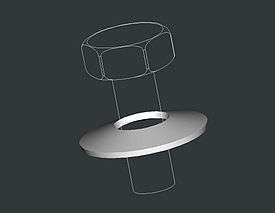 |
A washer with a slight conical shape, which provides an axial force when deformed. |
| Curved disc spring |  |
Similar to a Belleville, except the washer is curved in only one direction, therefore there are only four points of contact. Unlike Belleville washers, they exert only light pressures.[7] |
| Wave washers |  |
A washer with a "wave" in the axial direction, which provides spring pressure when compressed. Wave washers, of comparable size, do not produce as much force as Belleville washers. In Germany, they are sometimes used as lock washers, however they are less effective than other choices.[lower-alpha 1][8] |
| Split washer or spring lock washer |  |
A ring split at one point and bent into a helical shape. This causes the washer to exert a spring force between the fastener's head and the substrate, which maintains the washer hard against the substrate and the bolt thread hard against the nut or substrate thread, creating more friction and resistance to rotation. Applicable standards are ASME B18.21.1, DIN 127B, and United States Military Standard NASM 35338 (formerly MS 35338 and AN-935).[9]
Spring washers are a left hand helix and allow the thread to be tightened in a right hand direction only, i.e. a clockwise direction. When a left hand turning motion is applied, the raised edge bites into the underside of the bolt or nut and the part that it is bolted to, thus resisting turning. Therefore, spring washers are ineffective on left hand threads and hardened surfaces. Also, they are not to be used in conjunction with a flat washer under the spring washer, as this isolates the spring washer from biting into the component that will resist turning. Where a flat washer is required to span a large hole in a component, a nyloc nut (nylon insert) must be used. The use and effectiveness of spring lock washers has been in debate of late, with some publications advising against their use on the grounds that, when tight, the washer is flat against the substrate and gives no more resistance to rotation than a normal washer at the same torque. NASA researchers have gone as far as to say "In summary, a lockwasher of this type is useless for locking."[10][11] However, a spring washer will continue to hold the bolt against the substrate and maintain friction when loosened slightly, whereas a plain washer will not.[lower-alpha 2] |
| Toothed lock washer, serrated washer or star washer[8] | 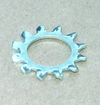 |
A washer with serrations that extend radially inward or outward to bite into the bearing surface. This type of washer is especially effective as a lock washer when used with a soft substrate, such as aluminium or plastic,[8] and can resist rotation more than a plain washer on hard surfaces, as the tension between washer and the surface is applied over a much smaller area (the teeth). There are four types: internal, external, combination, and countersunk. The internal style has the serrations along the inner edge of the washer, which makes them more aesthetically pleasing.[12] The external style has the serrations around the outer edge, which provides better holding power, because of the greater circumference.[13] The combination style has serrations about both edges, for maximum holding power.[14] The countersunk style is designed to be used with flat-head screws.[15]
Tooth lockwashers are also used for ground bonding where a metal lug or object must be electrically bonded to a surface. The teeth of the washer cut through surface oxides, paints or other finishes and provide a gas-tight conductive path. In these applications the washer is not placed under the head of the screw (or under the nut), it is placed between the surfaces to be bonded. In such applications, the tooth washer does not provide any anti-rotation locking features.[16] |
| Tab washer |  |
A locking washer that works by having a side tab that can be bent into place against a nut. Metallic or non-metallic, the tab washer notch prevents rotation relative to the shaft or fastener. Variations include single, multiple, formed and flat.[17] |
Lock washers, locknuts, jam nuts, and thread-locking fluid are ways to prevent vibration from loosening a bolted joint.
Gaskets
The term washer is often applied to various gasket types such as those used to seal the control valve in taps. Crush washers are made of a soft metal such as aluminium or copper and are used to seal fluid or gas connections such as those found in an internal combustion engine.
| Name | Image | Description |
|---|---|---|
| Shoulder washer | A plain washer type with integral cylindrical sleeve; they are used to keep separate different metal types, and as seals.[18] This term is also used for electrically insulating grommets.[19] |
Specialised types
| Name(s) | Image | Description |
|---|---|---|
| Keps nut or K-lock nut | 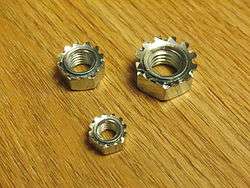 |
A nut with an integral free spinning washer; assembly is easier because the washer is captive. |
| Top hat washer | A shoulder washer type used in plumbing for tap fitting. | |
| Insulating shoulder washer | Used to electrically isolate a mounting screw from the surface it secures. Often made of nylon, these are also made of teflon, PEEK or other plastics to withstand higher temperatures. | |
| Keyed washer | A washer with a key to prevent rotation, and is used to lock two nuts in place, without allowing the torque applied to the top nut to cause the bottom nut to also rotate (such as in a threaded headset on a bicycle). | |
| Torque Limiting Washer | A type of washer used in a variety of torque sensitive applications, designed to limit torque to a predetermined level and not beyond. |
Materials
Washers can be fabricated from a variety of materials including, but not limited to:[20]
- Steel – Carbon steel, spring steel, 304 stainless steel, and 316/316A stainless steel
- Metal – Copper, brass, aluminium, titanium, iron, bronze, and zinc
- Alloy – Silicon bronze, Inconel, Monel, and Hastelloy
- Plastic – Thermoplastics and thermosetting polymers such as polyethylene, PTFE, and Teflon[21]
- Nylon – Nylon 6, Nylon 66, Nylatron, and Tecamid MDS[22]
- Specialty – Fibers, ceramics, rubber, felt, leather, bimetals, and mica
Corrosion resistance
A number of techniques are used to enhance the corrosion resistant properties of certain washer materials:
- Metallic coatings – Typical coatings used to produce corrosion resistant washers are zinc, cadmium, and nickel. Zinc coating acts as a sacrificial surface layer that falls victim to corrosive materials before the washer's material can be harmed. Cadmium produces a high-quality protective surface but is toxic, both biologically and environmentally. Nickel coatings add protection from corrosion only when the finish is dense and non-porous.
- Electroplating – This method involves coating the washer by electrolytic deposition using metals such as chromium or silver.
- Phosphating – A resilient, but abrasive surface is achieved by incorporating a zinc-phosphate layer and corrosion-protective oil.
- Browning or bluing – Exposing the washer (typically steel) to a chemical compound or alkali salt solution causes an oxidizing chemical reaction, which results in the creation of a corrosion-resistant, colored surface. The integrity of the coating can improved by treating the finished product with a water-displacing oil.
- Chemical plating – This technique utilizes a nickel-phosphor alloy that is precipitated onto the washer surface, creating an extremely corrosion- and abrasive-resistant surface.[23]
Standard metric flat washers sizes
Washers of standard metric sizes are listed in the table below. Measurements in the table refer to the dimensions of the washers as described by the drawing.

| Nominal screw sizes M (mm) |
Screw pitch thread P (mm) |
Internal (Inside) diameter hole d1 (mm) |
External (Outside) diameter d2 (mm) |
thickness H (mm) | ||
|---|---|---|---|---|---|---|
| 1st choice | 2nd choice | Coarse | Fine | |||
| 1 | 0.25 | 1.1 | 3 | 0.3 | ||
| 1.2 | 0.25 | 1.3 | 3.5 | 0.3 | ||
| 1.4 | 0.3 | 1.5 | 4 | 0.3 | ||
| 1.6 | 0.35 | 1.7 | 4 | 0.3 | ||
| 1.7 | 1.8 | 4.5 | 0.3 | |||
| 1.8 | 0.35 | |||||
| 2 | 0.4 | 2.2 | 5 | 0.3 | ||
| 2.5 | 0.45 | 2.7 | 6 | 0.5 | ||
| 2.6 | 2.8 | 7 | 0.5 | |||
| 3 | 0.5 | 3.2 | 7 | 0.5 | ||
| 3.5 | 0.6 | 3.7 | 8 | 0.5 | ||
| 4 | 0.7 | 4.3 | 9 | 0.8 | ||
| 5 | 0.8 | 5.3 | 10 | 1 | ||
| 6 | 1 | 0.75 | 6.4 | 12 | 1.6 | |
| 7 | 1 | 7.4 | 14 | 1.6 | ||
| 8 | 1.25 | 1 | 8.4 | 16 | 1.6 | |
| 10 | 1.5 | 1.25 or 1 | 10.5 | 20 | 2 | |
| 12 | 1.75 | 1.5 or 1.25 | 13 | 24 | 2.5 | |
| 14 | 2 | 1.5 | 15 | 28 | 2.5 | |
| 16 | 2 | 1.5 | 17 | 30 | 3 | |
| 18 | 2.5 | 2 or 1.5 | 19 | 34 | 3 | |
| 20 | 2.5 | 2 or 1.5 | 21 | 37 | 3 | |
| 22 | 2.5 | 2 or 1.5 | 23 | 39 | 3 | |
| 24 | 3 | 2 | 25 | 44 | 4 | |
| 27 | 3 | 2 | 28 | 50 | 4 | |
| 30 | 3.5 | 2 | 31 | 56 | 4 | |
| 33 | 3.5 | 2 | 34 | 60 | 5 | |
| 36 | 4 | 3 | 37 | 66 | 5 | |
| 39 | 4 | 3 | 40 | 72 | 6 | |
| 42 | 4.5 | 3 | 43 | 78 | 7 | |
| 45 | 4.5 | 3 | 46 | 85 | 7 | |
| 48 | 5 | 3 | 50 | 92 | 8 | |
| 52 | 5 | 4 | 54 | 98 | 8 | |
| 56 | 5.5 | 4 | 58 | 105 | 9 | |
| 60 | 5.5 | 4 | 62 | 110 | 9 | |
| 64 | 6 | 4 | 66 | 115 | 9 | |
| 68 | 70 | 120 | 10 | |||
| 72 | 74 | 125 | 10 | |||
| 76 | 78 | 135 | 10 | |||
| 80 | 82 | 140 | 12 | |||
| 85 | 87 | 145 | 12 | |||
| 90 | 93 | 160 | 12 | |||
| 100 | 104 | 175 | 14 | |||
See also
Notes
- ↑ Bowmans Fastener Technical Fast of 1999 on page 32 and 33 has SAE recommendation from 1969 that lock washers not be used in any critical application. BMW motorycles experienced a series of broken lock washers and BMW then disallowed their use in U joints due to the damage of loss of the spacer and nut loosening.
- ↑ Bowman Fastener (Barnes Co) in their Technical Series Fastener Facts Circa 1999 states on pages 32 and 33 states that lock washers are dangerous and obsolete and SAE recommended in 1969 that they not be used in any critical application other than sheet metal or inspection plates. BMW made them unacceptable in drive shafts as they were found to have broken and loss of space left the U-joint bolts loose and damage.
References
- ↑ http://www.straightdope.com/columns/read/1713/whats-the-purpose-of-washers-the-round-metal-things
- ↑ bokers.com
- ↑ Paul Green (2007). The Mechanical Engineering Drawing Desk Reference: Creating and Understanding ISO Standard Technical Drawings. Lulu.com / CreateSpace. Washers, p.205.
- ↑ Nikolas Davies; Erkki Jokiniemi (2008). Dictionary of architecture and building construction. Architectural Press. Flat Washer, p.153.
- ↑ Bucher, Ward (1996). Dictionary of Building Preservation. Preservation Press. p. 576.
- ↑ John Holloway (2010). Illustrated Theatre Production Guide. Focal Press. p. 202.
- ↑ McMaster-Carr catalog (115th ed.), McMaster-Carr, p. 1217, retrieved 2010-11-26.
- 1 2 3 Smith, Carroll (1990), Carroll Smith's Nuts, Bolts, Fasteners, and Plumbing Handbook, MotorBooks/MBI Publishing Company, p. 116, ISBN 0-87938-406-9.
- ↑ McMaster-Carr catalog (115th ed.), McMaster-Carr, pp. 3217–3218, retrieved 2010-11-25.
- ↑ IS 3063 : 1994 Fasteners - Single coil rectangular section spring lock washers - Specification
- ↑ "Fastener Design Manual" (PDF). NASA.gov. NASA.
- ↑ "Specifications for Internal Tooth Lock Washers ASME B18.21.1-1999" (PDF).
- ↑ "Specifications for External Tooth Lock Washers ASME B18.21.1-1999" (PDF).
- ↑ "Specifications for Internal/External Tooth Lock Washers ASME B18.21.1-1999" (PDF).
- ↑ "Specifications for Countersunk External Tooth Lock Washers ASME B18.21.1-1999" (PDF).
- ↑ "Improved Bonding and Grounding Methods for Electrical / Electronic Equipment" (PDF).
- ↑ ”What’s With Washers?”, Assembly Magazine, retrieved May 10, 2016.
- ↑ Fox, Brad; VanderWeyde, Peter (2008). Alloy boat corrosion: how to prevent it. Ripple Industries Pty Ltd. p. 16.
- ↑ "Fluorescent light". Popular Science. Bonnier Corporation. 186 (6): 117–118. June 1965. ISSN 0161-7370.
- ↑ "Stampings & Washers | Accutrex". www.accutrex.com. Retrieved 2016-02-11.
- ↑ Teflon PTFE Washers, New Process, retrieved May 10, 2016
- ↑ "Nylon Spacers And Washers - New Process Fibre". New Process Fibre Company, Inc. Retrieved 2016-02-11.
- ↑ "Washers Information | IHS Engineering360". www.globalspec.com. Retrieved 2016-02-11.
Further reading
- Parmley, Robert. (2000). "Section 11: Washers." Illustrated Sourcebook of Mechanical Components. New York: McGraw Hill. ISBN 0070486174 Drawings, designs and discussion of various uses of washers.
External links
| Wikimedia Commons has media related to Washers (hardware). |
- ASME Plain washer dimensions (Type A and Type B)
- Typical USA Flat Washer Dimensions USS, SAE, Fender, and NAS washer ID & OD (mm)
- American National Standard (ANSI) Type B Plain Washers
- SAE Flat Washers Type A Plain Washers
- USS & SAE Combined Flat Washer Dimensions
- Flat Washer Thickness Table Steel Gage Thicknesses, non-metric
- Split Lockwashers: Truth vs. Myth Hill Country Engineering